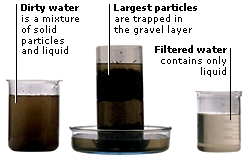DK Science: Separating Mixtures
The substances in a mixture are separated by the differences in their physical properties, such as their particle size. The more different the properties are, the easier it is to separate the substances. Tea leaves do not dissolve in water, so you can use a strainer to FILTER them. The particles in other mixtures can be far smaller; in CHROMATOGRAPHY, microscopic substances are separated by how easily each sticks to another substance.
To search for tiny particles of gold in rivers, a mixture of sand, mud, and gravel is scooped up in a pan and swirled around. Gold particles are heavier than the other particles, so they settle to the bottom of the pan. The lighter particles stay suspended in the water, and are decanted (poured off). This technique of panning for gold is called decanting. Cream is also separated from milk by decanting – the cream is less dense than the milk.
In distillation, a mixture of liquids is heated in a flask. The liquid with the lower boiling point evaporates (changes to a vapour) first, and is condensed (changes back to a liquid) and collected. The liquid with the higher boiling point and any solid particles are left behind in the flask. Fractional distillation separates liquids one by one as they boil. The oil industry separates crude oil using this technique.
When the substances in a mixture have different particle sizes, they are separated by filtration. The mixture is poured through a sieve or filter. The smaller particles slip through the holes, but the larger particles do not. Filtration is the first stage in water recycling. Chemists use filters called zeolites, which have holes so tiny that they can remove microscopic particles from water.

You can turn dirty water into clear water using a filter. Place a container with a hole in the bottom inside another container and line it with filter paper. Fill the container with layers of charcoal, sand, and gravel. Pour dirty water into the container. The layers will filter out smaller and smaller particles of dirt. The result is clearer (but not necessarily drinkable) water.
Scientists separate many liquid mixtures using chromatography. The mixture is dissolved in a liquid or a gas to make a solution. The solution is put on a solid material and the substances that dissolved most easily travel farthest up the solid material. The separated substances form bands of colour called chromatograms. Food scientists study chromatograms to discover which colourings a food contains.
Food scientists separate food colouring for analysis using paper chromatography. A drop of colouring is put onto filter paper. The edge of the filter paper is dipped in water. As the water flows up through the paper, it carries the colours with it. Some colours travel faster than others, so the substances split into different coloured bands.
Genetic scientists use thin layer chromatography (TLC) to study the substances that make up our genes. In TLC, the solid material is a plate of glass or plastic coated with a chemical, usually aluminium oxide or silicon oxide. When the liquid mixture travels up the plate, some of the substances move farther up the plate than others. The substances appear as spots on the plate. Scientists study genes to learn about inherited characteristics.

